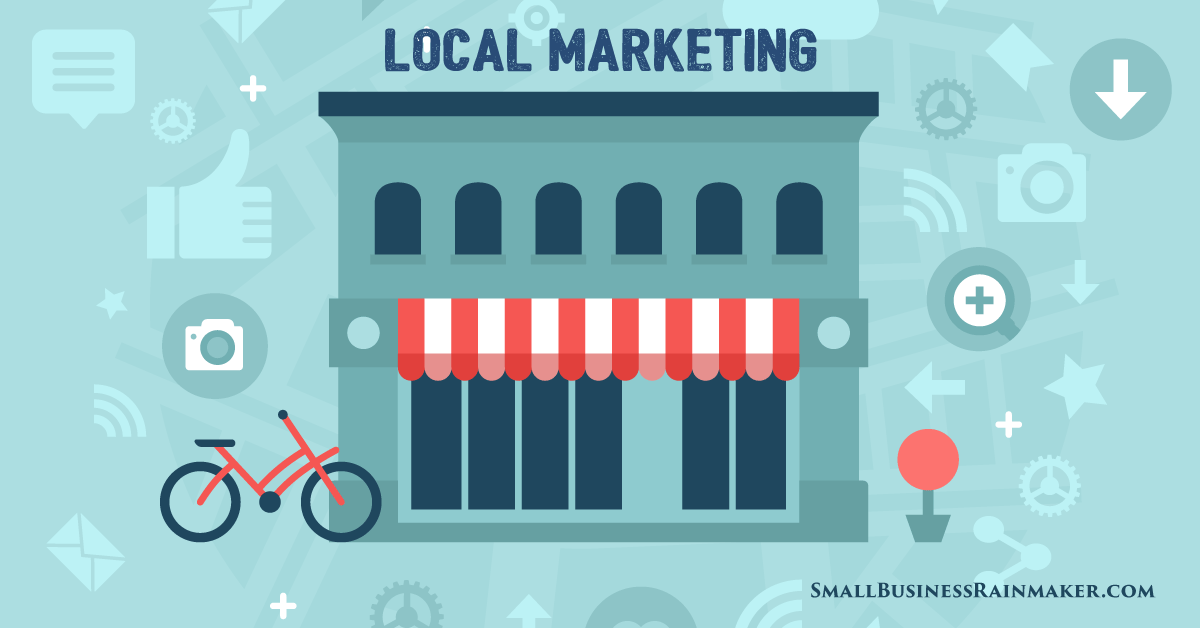
In these uncertain COVID-19 times, local businesses are struggling to stay afloat, and wondering how and when they'll be able to re-open or open wide.
The last thing on your mind may be working on your marketing. But the local businesses that see this difficult time as an opportunity will likely bounce back better and faster.
I've put together a variety of options for you to consider. Some are free, and some require only a small investment. Some will take time to install and see results, some will be quick to put in place and give you fairly speedy results. Not all of these things will be a good fit for you and your business, but they all deserve consideration.
Use this table of contents to jump to any section.
Why You Need a Diverse Local Small Business Marketing Strategy
Where to Start with Your Local Small Business Marketing Plan
5 Essential Local Business Marketing Strategies
Facebook Personal Account and Company Page
LinkedIn Personal Profile and Company Page
Online Local Business Directory Listings
2 Traditional Small Business Marketing Strategies That Still Work
More Local Small Business Marketing Strategies
Marketing Ideas for Quality Customer Service and Operations
Local Business Marketing Strategies to Build Engagement
Monitor Your Company’s and Your Personal Online Presence
Why You Need a Diverse Local Small Business Marketing Strategy
Do a quick Google search on “local business marketing.” You’ll see some 700,000 search results. A search on “small business marketing” yields close to 1 billion results.
Clearly, a massive amount of advice, resources, and information is available to you to market your local business.
Do a little reading and you’ll see that both online marketing and in-person efforts are needed for a successful marketing campaign.
This means proactive social media involvement to boost Search Engine Optimization (SEO) and extend your reach, along with in-person networking and installing business processes and practices for in-person interactions with your customers.
Quick Sprout, a leader in online marketing for small business, says:
"To survive, local businesses need to learn how to adapt to the modern way of marketing. If you are seeing a plateau or decline in sales, it’s time for you to mix up your marketing strategy.
Even if your small business is profitable right now, you need to stay ahead of your competition to remain successful in the future. Analyze the latest marketing trends. Recognize the consumer buying behavior. Learn how to get more money from your existing customers."
Where to start with your small business marketing plan
Before diving in, get straight on these three things to help you build a robust marketing strategy:
- Determine who your ideal customers are, and how they think and feel, by studying demographics and psychographics.
- Zero in on where they are physically located and where they hang out online.
- Create marketing messaging that will resonate with them. Show them that you understand them, and that you offer goods and/or services you know they need.
5 Essential Local Business Marketing Strategies
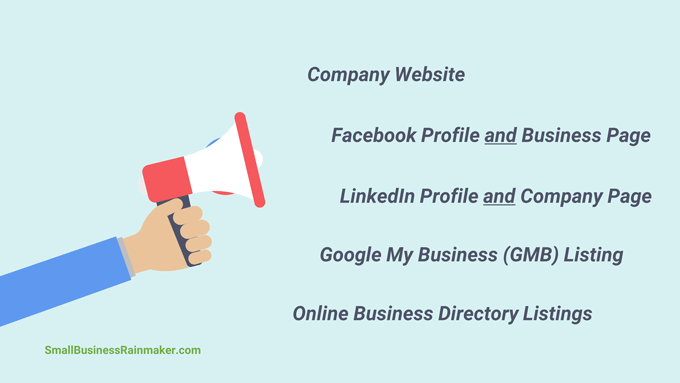
In this article you’ll find a number of specific small local business marketing ideas, but you should start with the following five must-do’s for a solid foundation to bolster all of your marketing efforts:
- An up-to-date company website/blog
- A Facebook personal profile AND company Page
- A LinkedIn personal profile AND company Page
- A Google My Business listing
- Online local business directory listings
Company Website
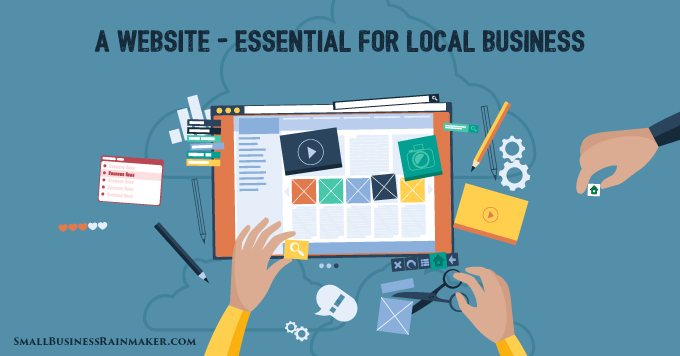
You may already have a website, but if it's an anemic site with only one or two pages that don’t provide much information, and if you put it up a while ago and haven't touched it since, it may actually be damaging. How do you think an untended website looks to potential customers?
I understand that many small business owners don’t have the capability to work on their websites. They have to hire someone to do it. So they rarely, if ever, do website work. If you have this situation, think about moving your website to a user-friendly platform so you can easily work on it yourself, or have an employee of yours do so.
Although you may get more action via your Facebook or LinkedIn company pages than you do through your website, you still need a website (that hopefully includes a blog) because:
- Your website is your main hub, your business powerhouse. Your various social media channels spoke out from it.
- Each page on your website is another web page associated with your company. More web pages means better online visibility.
- Your website will probably be the first search result when potential customers Google “your business name”. . . NOT your LinkedIn, Facebook, or other social media page.
- If you have no website or a poor one, or one you never update or touch, potential customers will wonder whether your business is real. You’ll turn off lots of people.
- You have complete control over your website and any content on it. A claim you can't make about any other social media platform.
- A blog on your website will exponentially boost your site’s SEO and increase your reach, visibility and engagement. Whenever you post to your blog, you can cross-post on your various social media channels.
A Quick Tip: Be sure your website footer contains your company name, physical address and phone (NAP), so that information shows up on all your website pages. Your NAP should be identical everywhere it is listed. Also include your NAP on your contact page, along with business hours.
Your website is a great place for video content. More about video later.
Facebook Personal Account and Company Page
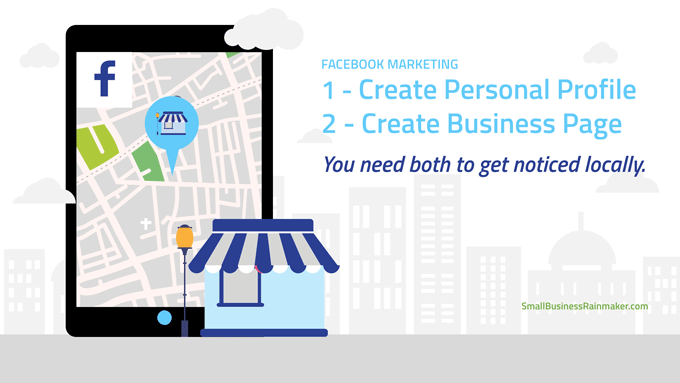
Set up both a personal account and a company page on Facebook. Particularly good for building local SEO, Facebook is where potential customers look for local providers.
But don’t stop after you create your personal and company pages. Stay active on both by posting regularly. Engage with your customers. Encourage them to write reviews on your company page.
And post regularly on both of your Facebook pages. How often? Katie Campbell, social media manager at Fundera, says:
"Post as frequently as you can and, at a minimum, once per day. Your audience and customers want to feel like they know your business and can relate to you."
Posting regularly is important, but so is posting quality content. Campbell advises sharing behind-the-scenes information and photos about your employees that show off your products and/or services.
She also suggests trying Facebook ads, especially if you're having trouble reaching users organically:
"Facebook's tools are very effective and make it easy to target a specific audience. You can target people who like your page or by location, age, gender and interests. Because Facebook collects user data, it can target your advertisement to those who are most likely to be interested in your product or service. The platform also features an analytics tool to helps you understand which ads drive interest and sales."
Small Business Rainmaker Founder Andre Palko advises that, in this COVID-19 time, Facebook ads are very attractive. Fewer businesses are using them, so prices are low.
He also suggests that now, more than ever, it’s time to get video and visual content into your Facebook company page. This need not be time-consuming or difficult to do. He’s developed Local Social Link™, a Done-For-You (DFY) Facebook visual content marketing program that sets you up with stunning visuals that post recurrently for months in advance. You don’t have to do a thing.
"Visual content campaigns that post every day to your page are proven to make you stand out in local search, get you more online referrals, get more engagement and repeat sales from current customers, and get more customers in the door."
LinkedIn Personal Profile and Company Page
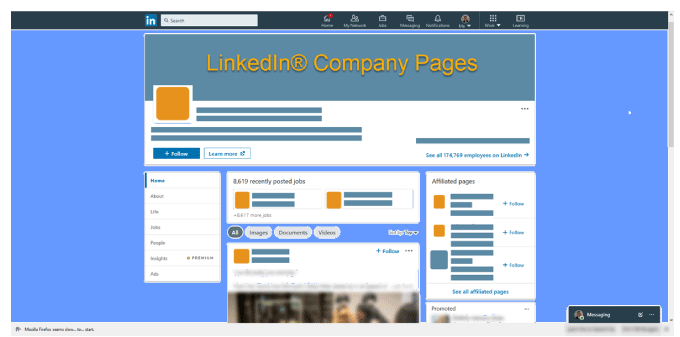
As I noted in an expansive article, LinkedIn for Business: 25 Things Every Owner Should Do, But Probably Doesn't:
"LinkedIn benefits small business owners in two ways:
PASSIVELY drawing potential customers to you. Make your profile a traffic magnet by building it out with lots of keyword-rich content. Once you do so, you won’t have to lift a finger to reap the passive benefits.
PROACTIVELY promoting and marketing your business and you. Stay active on LinkedIn. Use all the features and applications LinkedIn offers to demonstrate your subject matter expertise and stay top-of-mind with potential customers."
LinkedIn offers a more robust personal profile than Facebook, allowing for more content and therefore better SEO.
A fully fleshed out LinkedIn profile will typically land higher in search results than other social media, except for your website, as noted above.
Your personal LinkedIn profile is all about giving people a feel for your personal brand – that is, who you are and how you operate. Check out an article I wrote to help you write your LinkedIn profile.
Your LinkedIn company page is all about your company brand, services, and products.
Top Dog Social CEO Melonie Dodaro pointed out a few reasons why every small business needs a LinkedIn company page:
It looks professional. If a prospect looks for your LinkedIn page and doesn't find one, your credibility is shot.
It replaces the grey box. When you've created a LinkedIn page with your company logo, that logo will also appear in the Experience section of your personal profile with your various roles at your company. The logo will also appear in the Experience section of your employees' personal profiles, which helps build visual branding.
It affords more opportunities to be found. With status updates, job postings, and employee profiles, LinkedIn pages boost the chances that prospects will find your company. Additionally, your LinkedIn company page is extremely SEO-friendly. Often, your company page will come up high in the search results when someone Googles your company name.
Your employees can be connected to it. Having even only a few employees connected to your company page provides you with increased organic exposure. Also, your LinkedIn company page becomes a clickable link within the personal profile of each person who works for your company.
It offers highly-targeted LinkedIn advertising. When you post updates on your LinkedIn page you can target a specific audience. And you can pay for LinkedIn advertising to expand your reach.
How should you use your company profile on LinkedIn? Learn all about it in my article, How To Create and Use LinkedIn Company Pages for Your Small Business.
Google My Business (GMB)
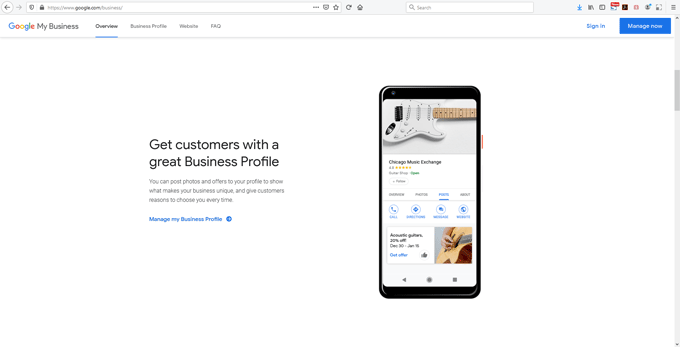
GMB is completely free and mostly geared towards local brick-and-mortar businesses. Particularly important, it helps you show up in “local business” and “near me” searches. It also works for virtual businesses, but you must use an actual physical address for your business when you sign up.
Google describes the value of GMB for local business:
Manage your information
Manage the information that Google users find when they search for your business, or the products and services that you offer. Businesses that verify their information with Google My Business are twice as likely to be considered reputable by consumers. When people find your business on Google Maps and Search, make sure they have access to information like your hours, website, and street address.
Interact with customers
Read and respond to reviews from your customers, and post photos that show off what you do. Businesses that add photos to their Business Profiles receive 42% more requests for directions on Google Maps, and 35% more clicks through to their websites than businesses that don’t.
Understand and expand your presence
Find insights on how customers searched for your business, and where those customers are coming from. You can also find information like how many people called your business directly from the phone number displayed on local search results in Search and Maps. When you’re ready, you can create and track the performance of Smart campaigns to spread the word about your work.
Marketing specialist Usman Raza described some ways to enhance your GMB page:
- Keep your info updated so people can find you.
- Turn snapshots into sales.
- Build loyalty by starting a conversation.
- Bring in business by sharing what’s new.
- Create repeat business with regular updates.
- Show events, blog posts, offers, and more.
And Google Ads (Pay-per-click) are an option you may be considering or already using. Invisible PPC notes:
"If you are using Google Ads search ads to generate new business, it is important to link your Google Ads account with your Google My Business account so that your potential customers experience a consistent brand across all mediums."
Online Local Business Directory Listings
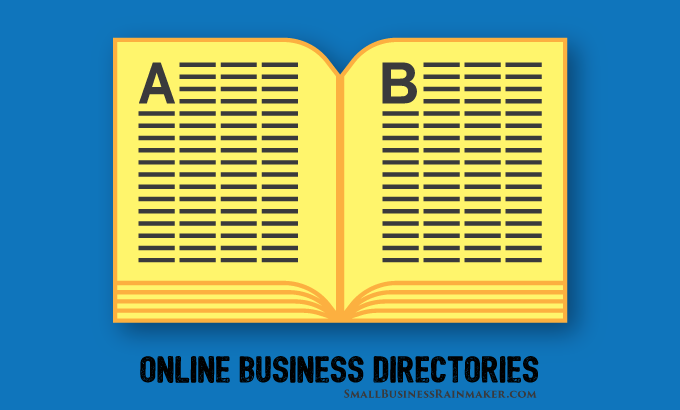
There are many online directories where you can create an account and extend your social reach.
Several of these directories may already have a profile for your company, whether you created it or not. They aggregate information about your business from various places online. Also, you may show up on a directory like Yelp, if customers rated and reviewed your business.
It’s up to you to monitor and clean up what’s on these sites.
The same Quick Sprout article I mentioned at the beginning of this article noted:
"It’s important that you make sure all your information such as your store hours, phone number, address, and website is accurate on these platforms.
More than 90% of consumers make a purchase after viewing a business on Yelp. If a customer tries to contact you and the phone number is wrong, or if they show up to your store thinking you’re open and you’re actually closed, it’s going to hurt you.
It’s in your best interest to claim your business on Yelp so that you can control the information in your listing."
Along with Yelp, here are some of the directories where you can claim your profile, or clean up or verify an existing listing:
- Angie's List
- Better Business Bureau
- BizJournals.com
- Whitepages and Yellowpages
- Manta
- Yext
- CitySearch
- MerchantCircle
- Trip Advisor
- Bing
- Zillow
- OpenTable
- Autotrader
2 Traditional Small Business Marketing Strategies That Still Work
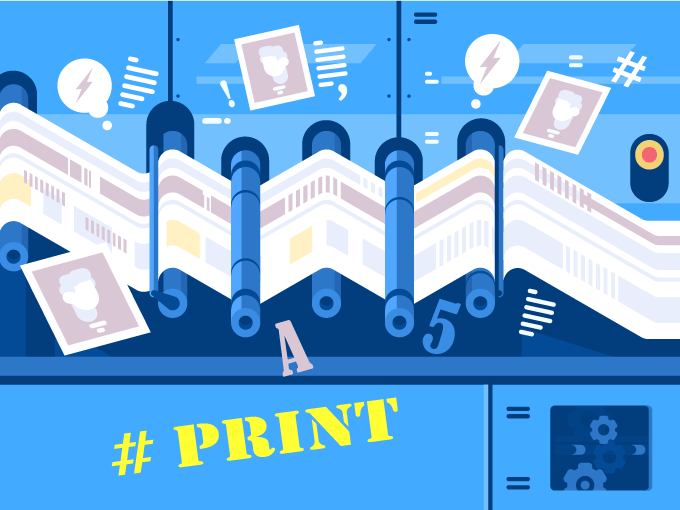
Direct Mail Campaigns
In particular, sequenced mailing, if done properly, will bring a significant ROI for any small business. This consists of a series of mailings sent one after the other, over a period of time, using snail-mailed letters or postcards, preferably hand addressed and on eye-catching papers. The content in the mailings typically relates to an event.
Palko explains that it's easy to understand why direct mail sequences work so well:
"How often have you laid a catalog or brochure on your desk, fully intending to buy an item that day? But things come up and you promise yourself you’ll get to it later. Finally you buy when another catalog or brochure shows up in the mail to remind you, perhaps weeks later."
He added some other ways a series of direct mailings works:
It allows you to further educate the customer. You have the opportunity to include supporting material such as testimonials, case studies, videos, white papers, cost studies, and more.
It lets you test various offers. People respond differently to different offers. For instance, one client may not care about paying in full at the time of purchase but loves free shipping, while another may need to budget the purchase over six months.
It gives you an opportunity to explore possible objections in greater detail.
It boosts your odds of hitting the client at the right time. Aside from having an urgent need, clients are ready to buy only when they’re ready to buy. When you send more letters (within reason) you increase your odds of acquiring that new client.
Additionally, your direct mailings can be integrated with your online marketing. For instance, you can alert people via direct mail about a webinar or podcast you’re hosting, or lead them to a product or service landing page on your website.
His five ways to use sequenced mailings include:
- Follow up to new leads in your pipeline.
- Follow up to new customers to say ‘thank you’ and eliminate buyer’s remorse.
- Follow up to new customers to advise of other products or services you have available.
- Introduce a new product to prospects and customers.
- Test customer response to a new product or service.
Print Media Ads
You may think that advertising in physically printed publications (newspapers, billboards, magazines, etc.) is not a viable option any more, but many small businesses successfully merge this kind of advertising with their digital marketing.
On the plus side, Brandon Ortiz, VP of Content Marketing at Celonis, indicated that print will allow brands to rise above the digital racket:
"The ubiquity of digital media has given print media a strange new power. Think of how special it is to get a written letter as opposed to an email. If you're trying to target a C-level audience, forget email -- their assistant will just hit delete. But if you take your e-book, print it as a nice brochure, and mail it to the exec's office, it might get to their desk and leave a lasting impression."
Jeannie Ruesch, Director of Marketing at bill.com, noted in the same article as above that print media ads need to complement and encourage digital interactions:
"If your target audience reads print magazines as a regular part of their day, there is still a reason to consider print ads in your marketing mix. However, you need to adjust the expectations of actions your audience will take. Print ads will be more effective if they are a complement to your digital campaigns already in play and entice readers to interact with your brand online."
Print ads can be quite costly and things can add up fast. If you haven’t done it wisely, your whole print media campaign can fall flat fast. The key will be to choose the right publications and the right messaging for each one, set a reasonable budget, integrate with your digital marketing, measure results, and shift focus as needed.
More Local Small Business Marketing Strategies

Engage in in-person networking with local groups.
Connect with other local small business owners and all kinds of people through various locally-based groups. Business Network International (BNI) and your town and/or county Chamber of Commerce are great places for B2B networking. Don't worry that your competitors may also be there. You may find opportunities to cross-promote with them (more about this later).
Volunteer with local community organizations.
You can give by contributing financially and/or giving your time. From time to time, you can do a promotion, giving a percentage to a cause. If you already give back, it's okay to let people know. People generally prefer to do business with companies who support local causes over ones that do not.
Send out press releases regularly.
Local and national publications are always hungry for stories and content. Get to know local press, editors, and journalists. When you have a new product or service offering, send out a press release. Any kind of special interest story about you and/or your business is local “news” that publications want.
Create branded merchandise to give to your customers.
Here are a few popular, fairly inexpensive items:
- Keychains
- Refrigerator magnets
- Pens
- Shopping bags
- Cloth tote bags
- Memo pads
- Post-it notes
Sell your branded merchandise.
You can also brand various items with your company logo and tagline (and phone number and address, where applicable), and sell them online and in your store.
If your customers are having good experiences, they'll be happy to buy souvenirs to remind them. This works particularly well for restaurants, but it’s something most other businesses should consider.
The merchandising options are endless, but here's a start:
- Hats or visors
- Mugs
- Sunglasses
- Jackets
- T-shirts
- Flashlights
- Umbrellas
- Kitchen tools
- Other tools
- Pocket knives
- Coolers
- Food and candy
- Coloring books
- Toys
- Golf balls
- Sporting goods
Marketing Ideas for Quality Customer Service and Operations

The way you and your staff treat your customers on every level – and each time you connect with them – is a marketing issue in and of itself. A quality customer experience can influence people to buy, and to keep coming back.
16 of the many things you can put in place for top quality customer service:
- A customer complaint system that turns unhappy customers into happy ones.
- A process that creates entrepreneurial employees who are empowered to make decisions.
- Systematized training for every new employee so each process runs smoothly and similarly.
- An employer/employee relationship that includes positive reinforcement. Catch them doing something right!
- A merchant credit card acceptance program to appeal to buyers who only use credit cards.
- A system to capture email addresses for every potential and active customer. Build your customer database!
- On-hold phone messages that keep their attention for longer holds, like a customized message describing your products and services.
- A clean, tidy establishment that makes customers comfortable.
- The means to capture customer testimonials and broadcast them on your website and other social media channels.
- Coupons and discount specials to close more sales.
- Customer rewards or loyalty program to build repeat business.
- A customer referral program to build your customer base.
- Frequent buyer cards that keep people coming back.
- Special offers for senior citizens.
- Special offers combined with donations to local non-profits/charities.
- Attractive exterior and interior signage that draws people in, such as an ever-changing exterior reader board, banners, window painting, neon signs, floor stand signs, door decals, posters, or vehicle signs.
Local Business Marketing Strategies to Build Engagement

Create a social media campaign that includes video and other visuals.
People engage with visual content more, and are more likely to buy, when visual content (especially video) is part of your marketing messaging.
Post regularly to social media channels that are relevant to your business. As noted earlier, Facebook and LinkedIn are two very powerful platforms to use, but anywhere your customers are hanging out is good, too.
Start a YouTube channel for your business as your video marketing home base. Then use video on all your other social platforms and your website.
Here are some statistics that should encourage you to embrace video:
- Videos posted anywhere online rank higher in Google, LinkedIn, and other search engines than plain content on a digital page.
- Videos are 10x more likely to be shared than other content.
- YouTube rankings help their Google search results.
- Video conversion rates are higher than other content.
- Videos are one of the best tools to build their brand online.
In an article about the power and speed of video to give you a competitive advantage, Palko said:
"If you want a chance to increase your online visibility, as well as your trust and credibility, and to do it almost instantly, video in general, and personal branding video in particular, should be part of your strategy."
Read the article for his real-life examples of how quickly video had an impact on his customers.
The types of videos small businesses use include:
- Explainer videos
- Interview videos
- FAQ videos
- Event promo videos
- Presentations
- Tutorials
- How-to videos
- Promo or teaser videos
- Thought leadership videos
- Webinars (a great way to build your customer list and educate people)
- Testimonials (from customers, colleagues, vendors)
- Case study videos (includes challenge and results)
- Company culture videos
- Product reviews
- Demo videos
- Recruitment videos (paid Sponsored updates on LinkedIn Pages)
- Vlogs or video blogs
- Personal branding or bio videos
But, you may be thinking, I don't do well on camera. I get nervous. Plus, I'm not very savvy with technology, and my budget doesn't allow for hiring a professional video creator.
One great option is CareerBrandVideos™, a new kind of personal branding video system that Palko, social media for careers expert Hannah Morgan, and I designed for entrepreneurs and others who understand the importance of personal branding.
People prefer doing business with providers they feel they know and like. Personal branding videos make that happen.
Create a newsletter campaign and send them out regularly.
If you've been building your customer base over time, as suggested above, use that ever-expanding list to touch base regularly with your customers, say, once a week or once a month at the least. Unlike your followers on social media, you own your email subscriber list.
Your newsletter can be very simple and even short. Let people know when you're running specials, provide a tip, direct them to an article of interest that you or someone else wrote. A mix of content that’s about 80% entertaining and informative, plus about 20% selling is a good way to go.
Let them know you're thinking of them, and they'll remember you. MailChimp is a good platform to get started with. It's free for up to 2,000 subscribers. Aweber is another solid platform and offers a guide, What to Write in your emails, along with 45 free business email templates to get you started.
Build cross-promotions or joint marketing ventures.
Team up with other local businesses to create and offer products and/or services. This creates a reason for their customers to visit you, and for your customers to visit them. There’s big potential here for faster growth. It's a win-win for everyone. Also, sponsor events hosted by you or co-hosted with another business.
Offer premiums.
Attract people to your establishment by offering free gifts with purchase. The gifts can even be the branded merchandise that you sell (as noted above).
Do special date events and promotions.
Coincide promotions and giveaways with an appropriate holiday or even your company's anniversary. Celebrating your anniversary reminds people how long you've been in business and gives an image of stability and longevity.
Set up a magnet trade-in program.
Edge out the competition in a crowded market. Offer your customers a discount, gift, or great deal when they bring in one of your competitor's magnets.
Create a “losing lottery tickets” offer.
Here's a great idea from Palko:
"Turn all those losers into winners. 'When you bring in your losing lottery ticket, we'll deduct it from your bill.'
An alternate version is the second chance sweepstakes. Each losing lottery ticket is an entry into your own contest. Do your own drawing (or random number selection) and pick the winner from the losing tickets you collected.
Of course, you'll also collect the name, address, and email of everyone when they enter the contest."
Offer a fishbowl business card draw.
An oldie but goodie, put a fishbowl or large see-through container on your counter (or somewhere visible in your establishment) to collect business cards. State when the drawing will be and for what particular prize.
Like the suggestion above, you'll capture their names, phone, email, etc. from their business cards for your customer database.
Monitor Your Company’s and Your Personal Online Presence
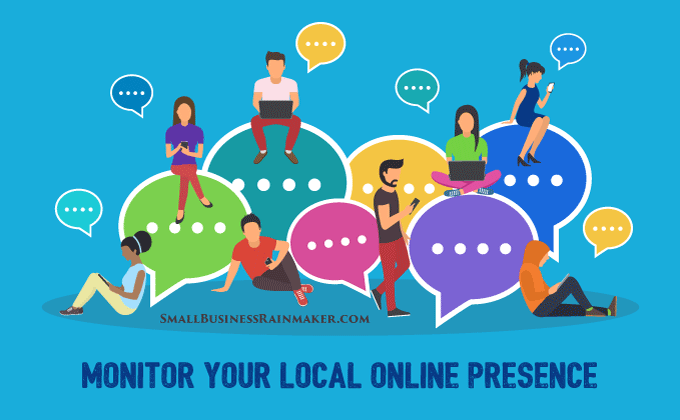
Here’s one last thing to tuck into your best-practices routine.
Your online marketing efforts will be jeopardized if your online presence (or your company’s) contains “digital dirt” or negative information about you.
Set up Google Alerts for “your company name”, “your name”, and various relevant keywords. Google will email you links to recently published web pages including those words. Stay on top of digital dirt AND positive news about your business.
But Google doesn’t catch everything, so also get into the habit of Googling “your company name” and “your name” regularly (say, every week or so), so that you will see exactly what potential customers see when they’re sourcing local businesses like yours.
Resources for Local Business
CareerBrandVideos™ – to promote your personal brand and accelerate business growth. Stand out. Be remembered. Attract opportunities.
Local Social Link™ for Facebook - Visual marketing campaigns for local businesses. Visuals are the #1 most engaging content on ALL social channels.
Local Business Videos - We customize our professional local business videos with your contact info and logo.










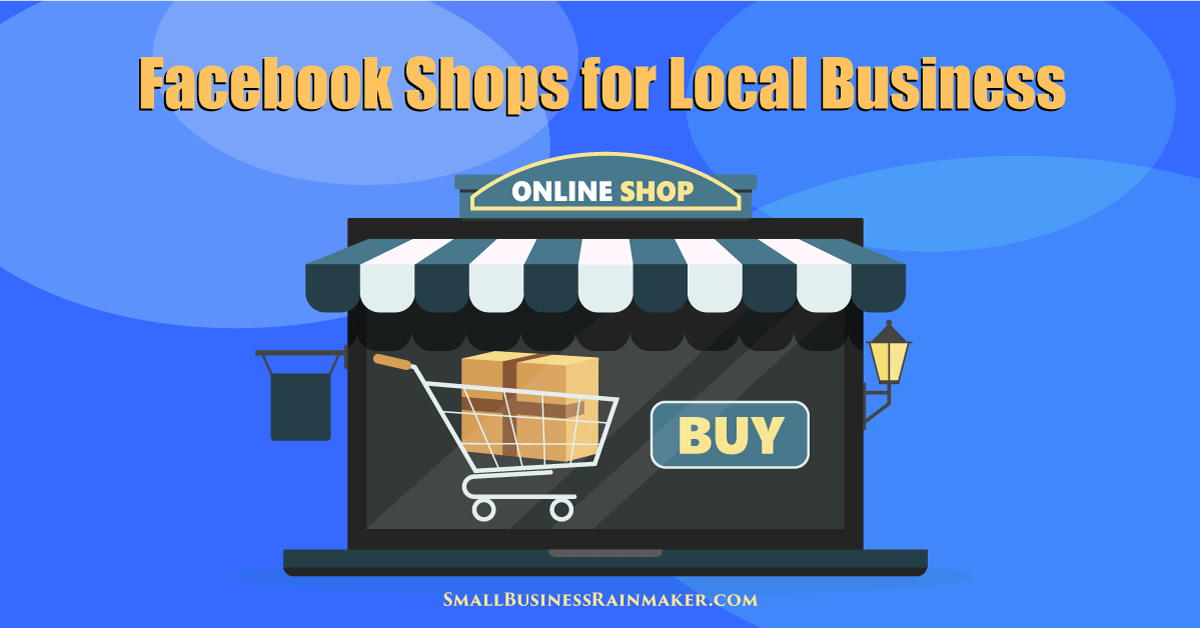

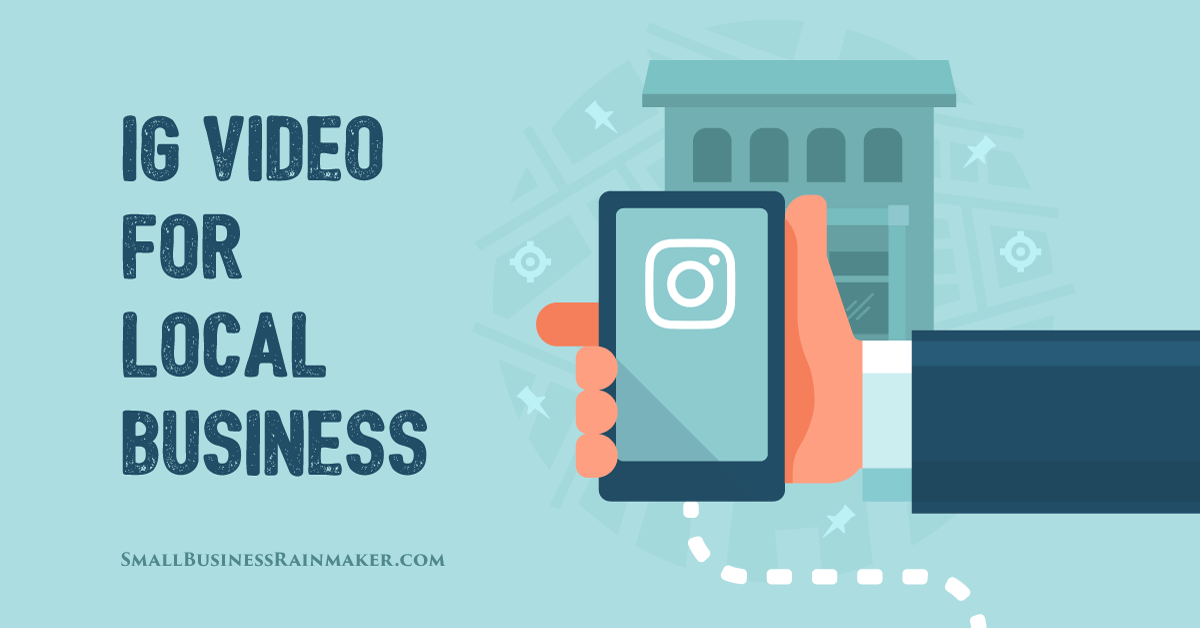


Leave a comment